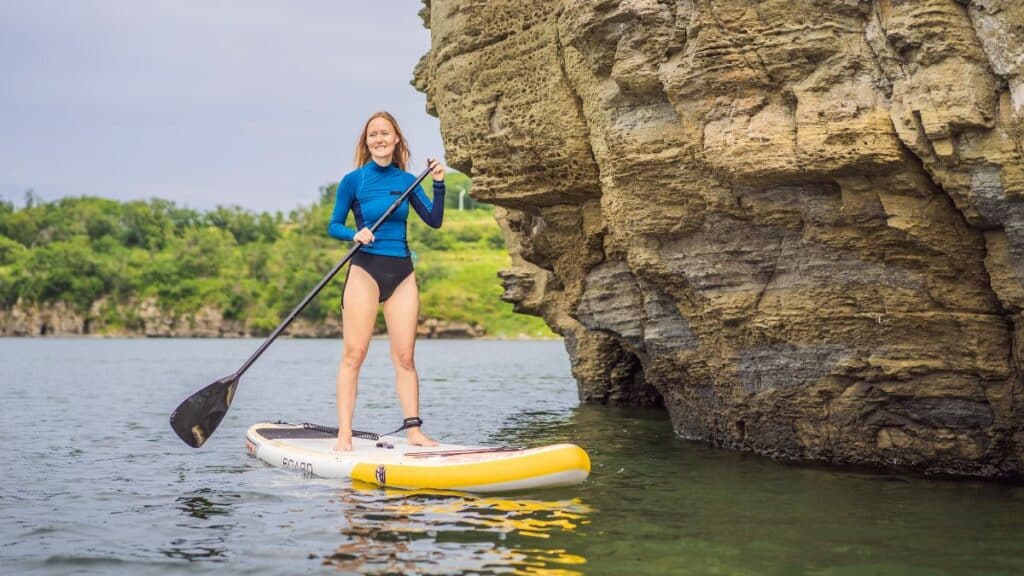Paddleboarding has emerged as a popular water sport, offering a delightful blend of relaxation, fitness, and adventure. Whether you’re a beginner or an experienced enthusiast, selecting the right size paddle board is paramount to ensuring an enjoyable experience on the water. In this comprehensive guide, we will explore the various factors you should consider when determining the ideal paddle board size to suit your needs and skill level.
Understanding Paddle Board Sizing
Paddle boards come in different sizes and shapes, designed to cater to diverse purposes and skill levels. Two crucial dimensions to consider are length and width. Longer boards generally provide better stability, higher weight capacity, and increased speed, making them suitable for beginners and those interested in touring or racing. Conversely, shorter boards offer greater maneuverability and are better suited for surfing and more advanced riders seeking agile performance.
Weight Considerations
When choosing a paddle board, your weight plays a significant role. The board should have sufficient volume to support your weight while maintaining stability. As a general rule, the greater your weight, the higher the volume (thickness and width) of the board you should consider. A wider board will provide better stability for heavier riders, while narrower boards offer increased responsiveness for lighter individuals. Here are some weight-based recommendations
- Lightweight Riders (Under 150 pounds): Opt for a narrower and shorter board for enhanced maneuverability and responsiveness. A board in the range of 9 to 10 feet in length and around 30 inches in width would be suitable.
- Average Weight Riders (150 to 200 pounds): A board between 10 and 11 feet in length and around 32 inches in width would provide a good balance of stability and maneuverability.
- Heavier Riders (Over 200 pounds): Consider a wider and longer board with increased volume to support your weight. A board around 11 to 12 feet in length and 34 inches in width would offer better stability and buoyancy.
Skill Level Considerations
Your skill level is an important factor in determining the appropriate paddle board size. Beginners should prioritize stability and ease of use, while advanced paddlers might prioritize maneuverability and performance.
Beginners
- Stability: Longer and wider boards (around 10 to 12 feet in length and 32 to 34 inches in width) provide better stability, making it easier to balance and paddle confidently.
- Ease of Use: A board with more volume (thickness) will offer better stability for beginners. Look for a board around 4.5 to 5.5 inches thick.
Intermediate to Advanced
- Maneuverability: Shorter boards (around 9 to 11 feet) offer improved maneuverability, allowing for quick turns and agility. Narrower boards (around 28 to 32 inches wide) enhance responsiveness.
- Performance: Advanced paddlers can opt for specialized boards designed for activities like surfing, touring, or racing, depending on their preferences. Surfing boards are generally shorter (around 9 feet) and narrower, while touring and racing boards are longer (12 to 14 feet) and narrower for improved speed and tracking.
Paddle Board Activities and Conditions
Surfing
For those seeking the exhilaration of riding waves, selecting a paddle board specifically designed for surfing is essential. These boards are crafted to provide optimal performance and maneuverability in the surf. When choosing a paddle board for surfing:
- Length: Surfing boards are typically shorter, ranging from 7 to 10 feet in length. Shorter boards offer increased maneuverability and responsiveness, allowing you to navigate the dynamic waves with agility.
- Width: Surfing boards tend to be narrower compared to other types of paddle boards. A narrower width, typically around 28 to 32 inches, allows for quicker turns and facilitates carving across the face of the wave.
- Rocker: Rocker refers to the curvature of the board from nose to tail. Surfing paddle boards have a pronounced rocker to handle steep drops and provide better control on the face of the wave. Look for a board with a significant rocker for optimal surfing performance.
- Fins: Fins play a crucial role in a surfboard’s performance. Thruster (three fins) and quad (four fins) setups are popular choices for surfing paddle boards, offering stability, control, and enhanced maneuverability on the waves. Experimenting with different fin configurations can help you find the setup that suits your surfing style.
- Construction: Surfing paddle boards are often constructed with lightweight and durable materials to withstand the rigors of wave riding. Epoxy or carbon fiber construction is commonly used to ensure strength and responsiveness.
Remember, surfing paddle boards are specifically designed for the unique demands of wave riding. It’s essential to consider your skill level and the size of waves you intend to surf when selecting the appropriate board. Consulting with experienced surfers or visiting a local surf shop can provide valuable insights and guidance in choosing the perfect paddle board for your surfing adventures.
Touring and Recreational Paddling
If you plan to embark on long-distance paddling adventures or enjoy recreational paddling in calm waters, choosing the right paddle board size is crucial for maximizing your experience.
- Length: Opt for a longer board (around 11 to 12.6 feet) that offers better tracking and stability, allowing you to cover greater distances with ease. Longer boards also tend to have a higher weight capacity, allowing you to carry gear or a companion if desired.
- Width: A wider board (around 30 to 32 inches) provides increased stability, making it easier to maintain balance during longer paddling sessions or when encountering small waves or boat wakes.
- Volume: Consider a board with ample volume (thickness) to support your weight and any additional gear you may carry. Aim for a board with a thickness of around 5 to 6 inches.
- Shape: Look for a board with a displacement hull or a touring-specific design. These boards are designed to cut through the water efficiently, providing better tracking and reducing fatigue during extended paddling sessions.
It’s important to note that inflatable paddle boards have gained popularity for touring and recreational paddling due to their portability and convenience. Inflatable boards can be easily deflated, rolled up, and transported in a backpack, making them ideal for travel and storage.
Yoga and Fitness
Paddleboarding has also become a popular platform for practicing yoga and fitness exercises. If you’re interested in incorporating yoga or fitness routines into your paddleboarding experience, consider the following factors:
- Stability: Opt for a wider and more stable board (around 32 to 36 inches) that allows for ample deck space and provides a solid platform for performing yoga poses and fitness exercises.
- Length: A medium-sized board (around 10 to 12 feet) strikes a balance between stability and maneuverability. It should provide enough space for yoga poses without compromising maneuverability during short paddling distances.
- Deck Pad: Look for a paddle board with a soft and comfortable deck pad that offers good traction. This will enhance your grip and stability during yoga and fitness activities.
Remember to check if the board has attachment points for securing accessories like anchor systems or bungee cords, as these can be useful for anchoring during yoga sessions or attaching fitness equipment.
Conclusion
Choosing the right size paddle board is crucial for optimizing your performance and enjoyment on the water. By considering factors such as your weight, skill level, intended activities, and prevailing conditions, you can make an informed decision. Remember, longer and wider boards offer greater stability, while shorter and narrower boards provide improved maneuverability. Additionally, inflatable paddle boards have become a popular choice for their portability and convenience.
It’s always recommended to try out different boards before making a purchase to ensure the perfect fit for your needs. Consulting with knowledgeable paddle boarders or experts can also provide valuable insights.
Investing time in researching and understanding the factors mentioned in this guide will help you select the paddle board that suits you best. Whether you’re gliding through waves, exploring serene lakes, or engaging in yoga and fitness activities, the right size paddle board will enhance your overall experience, allowing you to fully immerse yourself in the joys of paddleboarding. So, grab your paddle, choose your perfect board, and embark on your paddleboarding adventures with confidence!
Meet Eric McGough, a seasoned adventurer and military veteran who traded his tech career for a life of outdoor exploration and freedom. He plans to travel the world, discover new adventures, and share information about great destinations, gear, and more on the Shaman Mountain Sports and Outdoors Blog.





